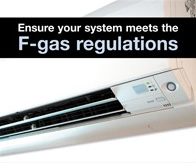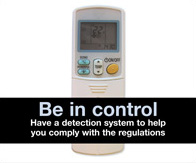- What it means for you
- Do you have a leak detection system installed?
- Who needs to install a system?
 On 4th July 2006 The European Union’s F-gas Regulation No 842/2006 became law and for the majority of measures took effect from 4 July 2007, the new F-Gas regulation is (EC) 517/2014 and came into effect on 1st January 2015
On 4th July 2006 The European Union’s F-gas Regulation No 842/2006 became law and for the majority of measures took effect from 4 July 2007, the new F-Gas regulation is (EC) 517/2014 and came into effect on 1st January 2015
The regulation aims to contain, prevent and thereby reduce emissions of the fluorinated greenhouse gases (F-gases) covered by the Kyoto Protocol.
This page gives a brief summary of its requirements for the UK’s Refrigeration, Air Conditioning, Heat-pump and Fire Protection Industry, which initially came into effect on 1st Jan 2015 and was superseded 1st January 2015 (F-gases include all HFC refrigerants, such as R134a, R407C, R32 and R410A.)
Leak detection is an import part of this regulation. The tables below give the specific regulatory requirements when a CFC, HCFC, freon (refrigerant / air conditioning / heat-pump gas) leak detection system is required.
The objective of the F-Gas Regulation is to prevent leakage and to ensure repairs are undertaken as soon as possible after a leak is detected.
The European Commission has stated that a recast of the F-gas Regulation is likely by end of 2021, in line with the climate law proposal, which requires the Commission to review, and where necessary propose to revise by June 2021, all relevant policy instruments to achieve the additional 2030 emission reductions.
New technologies, sustainable solutions and disruptive innovation are critical to achieve the objectives of the European Green Deal.
HFOs and HCFOs are a disruptive technology that bridges the historical divide between maximizing safety (achieved through the use of non-flammable, low order of toxicity, but high GWP HFCs) and minimizing GWP (achieved through the use of low GWP, but highly flammable hydrocarbons or toxic ammonia). The available HFOs and HCFOs have varied physical properties enabling the optimum choice to be selected for a diverse range of applications, something that cannot be achieved with CO2.
Mildly flammable A2L low GWP HFCs and HFC/HFO blend refrigerants provide a good balance of safety, environmental and technical properties. Lower GWP non-flammable HFC/HFO blends allow the replacement of high GWP HFCs.
The information contained on these pages provide details and links to the range of AquiTron f-gas leak detection systems essential for the compliance with this regulation.







 Installing a refrigerant Leak Detection system will save time and money by reducing inspection and maintenance costs, and help you comply with the F-Gas regulation.
Installing a refrigerant Leak Detection system will save time and money by reducing inspection and maintenance costs, and help you comply with the F-Gas regulation.